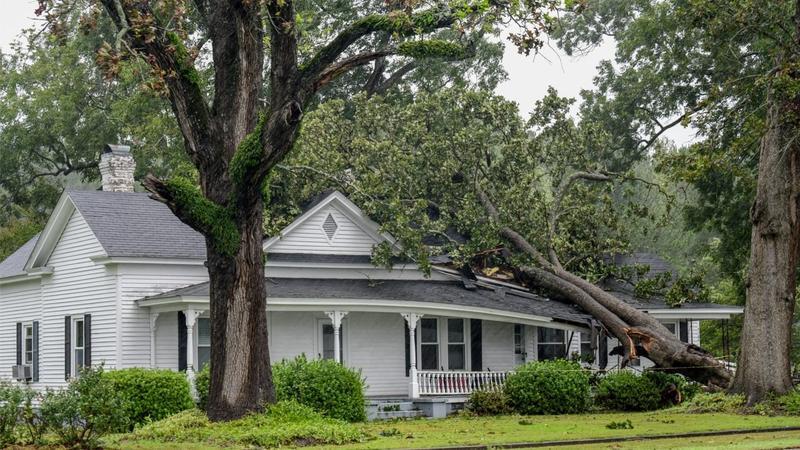A severe windstorm passed through Ontario and Quebec in May, causing widespread damage to properties and public infrastructure. While it is too soon to tell how much insurable damage occurred, trees, in particular, caused a lot of grief and left many people with home insurance questions — whether they were touched by the destruction or not.
With more powerful storms in the forecast this summer, we seek to answer your top home and auto insurance questions about trees.
Will my home insurance cover damage to my home from a fallen tree?
Typically, your home insurance will cover any damage caused to your property due to a fallen tree. However, much of this coverage depends on the condition of your tree and how well you’ve maintained it.
For example, if the tree was dead before it fell, your home insurance might not cover the damage as it could be classified as a “hazard” under your policy. In most cases, a dead tree is considered a liability, and if you did not take steps to remove a dead tree, you might be found negligent.
You may also be found liable if you did not take steps to prevent your tree from becoming a hazard, such as failing to trim branches or remove dead ones.
Will my home insurance cover damage to my neighbour’s home caused by a fallen tree?
If a tree fell on your property but damaged your neighbour’s house, they are responsible for filing a claim through their own home insurance company. However, they may have the right to sue for compensation.
“A tree on your property damaging your neighbour’s property or a neighbour’s tree causing damage to your property is a civil issue between private property owners,” The City of Toronto website states. “If you are unable to reach an agreement with your neighbour and want to determine your legal rights, contact a lawyer.”
Will my auto insurance cover damage to my vehicle caused by a fallen tree?
If a tree fell on your vehicle, causing damage, you would likely be covered under your auto insurance policy as long as you have comprehensive or specified perils coverage, both of which are optional.
Comprehensive coverage typically covers non-collision-related damage, such as hail, wind, fire, theft, and vandalism. Whereas specified perils coverage only covers losses by perils specifically listed on the policy, such as earthquakes or windstorms.
A tree fell on my property but did not damage anything. Now what?
If the tree fell without damaging private property, it’s unlikely that your insurance will provide coverage.
Sometimes, a city may remove the tree if it falls on public property such as roads or power lines. But generally, any trees on private property are the property owner’s responsibility. It’s their job to arrange for the removal of the tree and any debris.
Will my insurance cover the cost of removing my tree
Home insurance policies may cover the cost of removing a tree, but there is usually a cap of $500 to $1,000 per tree, and that is only if the tree causes damage. Before removing a tree, however, cities generally recommend hiring a private arborist to review the extent of the damage and determine if removal is required.
Toronto, for example, has tree preservation by-laws in place. These tree regulations prevent you from removing a tree without a permit. If the tree poses an imminent hazard, you must contact the Urban Forestry department first. Suppose you cannot reach Urban Forestry, but the tree needs to be removed immediately. In that case, you must document the damage with photographs and provide a written record of your removal and actions. Removing a by-law protected tree without a permit is illegal in Toronto and can result in fines of up to $100,000 per tree.
Permits to remove a tree may only be issued on the condition you replace it.
Will my insurance cover the cost of replacing my tree?
Standard home insurance policies replace trees damaged due to perils, including fire and lightning, but most exclude trees damaged by water and wind. Cities also don’t typically provide funding for replacing trees on private property.
How to protect your home from falling trees
Here are a few steps you can take to prevent tree and falling debris damage to your home:
- Ensure your tree is adequately pruned by trimming branches and removing dead ones. Consult a professional arborist to ensure your pruning does not cause more damage to the tree
- Ensure your home can withstand harsh wind and rainstorms by inspecting and maintaining the roof, gutters, and fences.
- Look for warning signs regarding your tree’s health. If you notice your tree has mushrooms growing on it, the trunk is cracked or hollowed, or limbs hanging over a power line, phone an arborist to seek a recommendation.
What to do if a tree falls on your house
If a tree falls on your house, follow these steps when it is safe to do so:
- Make sure everyone is okay and, if possible, get out of the house. Ensure your area is not at risk of further falling trees.
- Call emergency services so they can make sure your house is safe. This may include calls to hydro and gas companies.
- Call your insurance provider to report the incident and discuss how to proceed. Usually, your insurance company will require you to document the damage with photos and detailed notes.
- Ask your insurance provider whether you are entitled to living expenses if you are unable to live in the home. Suppose you can’t stay in your house. In that case, secure doors and windows and put any valuables in storage.
- Make arrangements to have contractors repair your home and prevent additional damage. Keep the receipts related to the cleanup.
A tree falling on your house can be a frightening inconvenience, but you can rest assured knowing that you’re likely protected under your home insurance policy.
